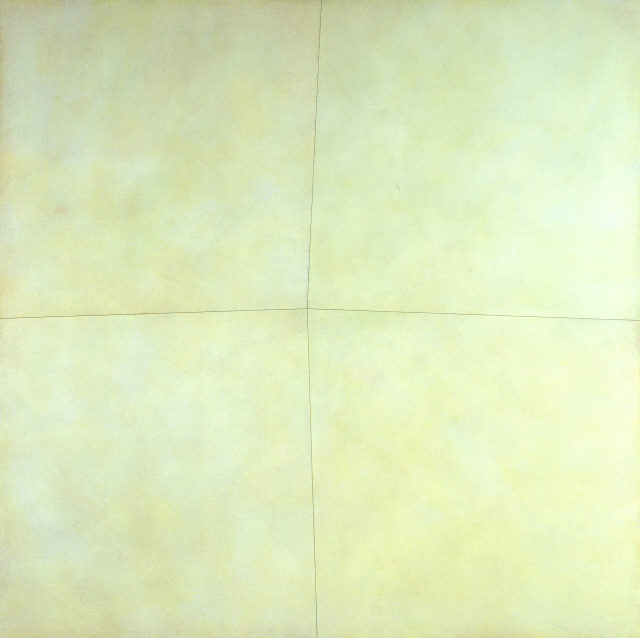
- Canvas
- Acrylic paint
- Inv. 86P579
Ângelo de Sousa
86-3-15Q
For Ângelo de Sousa colour is a matter of choice, arrangement and intensity, and even a single line can be drawn in a vast range of variations. He moves from lines of colour to whole swathes in drawings and paintings: strips where a figure is captured or signs are inscribed, or bordered by their complementary colour, ovals and bright segments, sheets and layers, chromatic fractions descending and converging into a valley or a rainbow.
Works such as Geométrico Grande [Large Geometrical Painting] (1967), which is made up of coloured triangles arranged both on a flat plane and in such a way as to suggest volume through a combination of optical effects conjured by the colour and its positioning in relation to each polygon, and works that feature minute flecks in many different colours, from the same year, pre-date the gradual introduction of different chromatic elements which some of the artist's paintings from 1972 and 1973 already show to an advanced degree, with small patches and layers still discernable on the surface. From this point on, his paintings would show a commitment to this approach, as is the case with his canvases entirely steeped in an even shade of yellow, orange or green, where one can just about make out underlying layers in other colours, pulsating beneath like the secret ingredient for a saturated, shimmering and intense surface.
The steady movement from the demarcation to the contamination of territories extends to various works dating from the 1970s, 80s and 90s. The background and the form share the same plane, and not infrequently a vague geometrical line calls for a certain effort on the part of the viewer. The lines mark out frontiers which do not set apart any natural difference. The depth of these paintings is geological rather than representative. It alludes to layers, not vanishing points. It is based on the imperceptible, and submersion into a chromatic density beneath the dominant colour. In the Monócromos [Monochromes] some colours weigh beneath others, and a mere line which splits into two angles, almost rendered invisible for being so obtuse, and the subtle slope of the line that divides what might be mosaics, recalls that latent colour.
One of the comments most frequently made about Ângelo de Sousa is that he brings together concepts such as renouncement, economy, structural nudity, essentiality, rigour, empty space, purity, stylisation, and austere, minimal, basic vocabulary. Such attributes mean that critics frequently refer to minimalism when discussing Ângelo de Sousa. However, he was never a follower of the American minimalist movement. Ernesto de Sousa explains it well in an article published in the magazine Colóquio-Artes in June 1975, in which he says that “all of Ângelo de Sousa’s works reveal a rigorous and logical investigation in the sense of the “minimalist” practice, without this meaning that the artist has made a commitment to minimalism”.
Ângelo de Sousa himself made the famous following statement about his quest for purity: “Maximum effect with minimum resources; maximum efficiency with minimum effort; maximum presence with a minimum of screaming”.
Leonor Nazaré
May 2013
| Type | Value | Unit | Section |
| Width | 169,8 | cm | |
| Height | 170 | cm | |
| Width | 175,3 | cm | |
| Height | 175,5 | cm | |
| Depth | 5 | cm |
| Type | materials |
| Type | techniques |
| Type | location |
| Type | date |
| Type | signature |
| Type | title |
| Type | dimensions |
| Type | Acquisition |
| 50 Anos de Arte Portuguesa |
| Lisboa, Fundação Calouste Gulbenkian, 2007 |
| ISBN:978-972-678-043-4 |
| Catálogo de exposição |
| III Exposição de Artes Plásticas |
| Lisboa, Fundação Calouste Gulbenkian - Centro de Arte Moderna, 1986 |
| Catálogo de exposição |
| Entre Duas Luzes - Obras da colecção do Centro de Arte Moderna José de Azeredo Perdigão |
| Lisboa, Assembleia da República, 2004 |
| ISBN:972 556 365 4 |
| Catálogo de exposição |
| Arte Contemporáneo Portugués |
| Lisboa, Fundação Calouste Gulbenkian, Centro de Arte Moderna, 1987 |
| Catálogo de exposição |
| III Exposição de Artes Plásticas |
| CAM/FCG |
| Curator: CAM/FCG |
| 20 de Julho de 1986 a 31 de Agosto de 1986 Galeria de Exposições Temporárias da sede Piso 0 e Hall dos Congressos |
| Exposição de comemoração do 30.º aniversário da FCG |
| Entre Duas Luzes - Obras da colecção do Centro de Arte Moderna José de Azeredo Perdigão |
| Jorge Molder |
| Curator: CAMJAP/FCG |
| Novembro de 2004 a Fevereiro de 2005 Assembleia da República |
| Exposição realizada na Assembleia da República. |
| Arte Contemporáneo Portugués |
| Fundação Calouste Gulbenkian |
| Curator: CAM/FCG |
| Fevereiro de 1987 a Março de 1987 Madrid, Museo Espanõl de Arte Contemporáneo |
| Exposição organizada pelo CAM e pelos ministérios dos "Asuntos Exteriores" e da Cultura de Espanha. A exposição apresentou obras da Colecção do Centro de Arte Moderna e de colecções particulares. |
| 50 Anos de Arte Portuguesa |
| Fundação Calouste Gulbenkian |
| Curator: Fundação Calouste Gulbenkian |
| 6 de Junho de 2007 a 9 de Setembro de 2007 Sede da FCG, Piso 0 e 01 |
| Exposição programada pelo Serviço de Belas-Artes e pelo Centro de Arte Moderna, da Fundação Calouste Gulbenkian.Comissariado: Raquel Henriques da Silva, Ana Ruivo e Ana Filipa Candeias |
